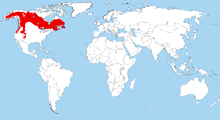Perisoreus
The genus Perisoreus is a very small genus of jays from the Boreal regions of North America and Eurasia from Scandinavia to the Asian seaboard. An isolated species also occurs in north-western Szechuan province of China. They belong to the Passerine order of birds in the family Corvidae. Not closely related to other birds known as jays, they are instead related to the genus Cyanopica.[1]
| Perisoreus | |
|---|---|
 | |
| Canada jay (Perisoreus canadensis) | |
| Scientific classification | |
| Kingdom: | Animalia |
| Phylum: | Chordata |
| Class: | Aves |
| Order: | Passeriformes |
| Family: | Corvidae |
| Genus: | Perisoreus Bonaparte, 1831 |
The genus was introduced by the French zoologist Charles Lucien Bonaparte in 1831.[2] The type species was subsequently designated as the Canada jay.[3] The name of the genus may come from the Ancient Greek perisōreuō "to heap up" or "bury beneath". Alternatively it may be from the Latin peri- "very" or "exceedingly" and sorix, a bird of augury dedicated to Saturn.[4]
Species
The genus contains three species.[5]
| Common name | Scientific name [lower-alpha 1] | IUCN Red List Status | Distribution | Picture | ||
|---|---|---|---|---|---|---|
| Status | Trend | Population[lower-alpha 2] | ||||
| Canada jay | Perisoreus canadensis (Linnaeus, 1766) |
LC IUCN[6] | 26,000,000 |  |
 | |
| Siberian jay | Perisoreus infaustus (Linnaeus, 1758) |
LC IUCN[7] | 4,000,000 - 7,999,999 |  |
_(13667845783).jpg) | |
| Sichuan jay | Perisoreus internigrans (Thayer & Bangs, 1912) |
VU IUCN[8] | 2,500 - 9,999 | China |  | |
Notes
- A binomial authority in parentheses indicates that the species was originally described in a genus other than Perisoreus.
- Estimate for the number of mature individuals in the wild.
References
- Ericson, Per G. P.; Jansén, Anna-Lee; Johansson, Ulf S.; Ekman, Jan (2005). "Inter-generic relationships of the crows, jays, magpies and allied groups (Aves: Corvidae) based on nucleotide sequence data" (PDF). Journal of Avian Biology. 36 (3): 222–234. CiteSeerX 10.1.1.493.5531. doi:10.1111/j.0908-8857.2001.03409.x.
- Bonaparte, Charles Lucien (1831). "Saggio di una distribuzione metodica degli Animali Vertebrati di Carlo Luciano Bonaparte principe di Musignano". Giornale Arcadico di Scienze, Lettre ed Arti. 49: 3–77 [42].
- Mayr, Ernst; Greenway, James C. Jr, eds. (1962). Check-list of birds of the world. Volume 15. Cambridge, Massachusetts: Museum of Comparative Zoology. p. 235.
- Jobling, J.A. (2018). del Hoyo, J.; Elliott, A.; Sargatal, J.; Christie, D.A.; de Juana, E. (eds.). "Key to Scientific Names in Ornithology". Handbook of the Birds of the World Alive. Lynx Edicions. Retrieved 16 May 2018.
- Gill, Frank; Donsker, David, eds. (2018). "Crows, mudnesters, birds-of-paradise". World Bird List Version 8.1. International Ornithologists' Union. Retrieved 16 May 2018.
- BirdLife International (2016). "Perisoreus canadensis". IUCN Red List of Threatened Species. 2016: e.T22705783A94035434. doi:10.2305/IUCN.UK.2016-3.RLTS.T22705783A94035434.en.
- BirdLife International (2012). "Perisoreus infaustus". IUCN Red List of Threatened Species. 2012. Retrieved 26 November 2013.CS1 maint: ref=harv (link)
- BirdLife International (2012). "Perisoreus internigrans". IUCN Red List of Threatened Species. 2012. Retrieved 26 November 2013.CS1 maint: ref=harv (link)